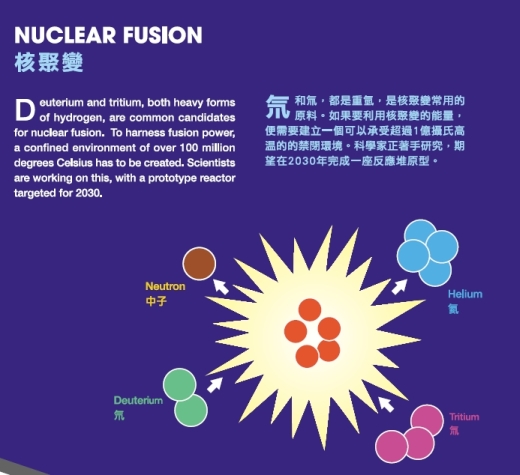Radiation Tidbits - Inexhaustible supply of nuclear energy
Written by: Yeung Siu-wai
As the world's storage of oil, coal and natural gas decreases, more and more people support the use of nuclear energy. The number of nuclear power plants around the world is ever increasing. However, is the supply of nuclear energy really inexhaustible?
- What is nuclear energy?
- How does nuclear power plant generate electricity?
- What kind of nuclear fuel is used in nuclear power plants? Where does it come from?
- How long can the world's uranium resources maintain the generation of electricity?
- Is there any other means to increase the supply of uranium?
- What is nuclear energy?
Nuclear energy is released when the structure of an atom's nucleus changes, either under nuclear fission or nuclear fusion. In nuclear fission, relatively large nuclei such as those of uranium and plutonium split. In nuclear fusion, relatively small nuclei such as those of deuterium and tritium combine. In both cases, a large amount of concentrated energy will be released, which is called the nuclear energy. Nowadays, scientists still cannot control the process of nuclear fusion effectively, thus nuclear fission is used to generate electricity in all existing nuclear power plants.


- How does nuclear power plant generate electricity?
Nuclear fuel inside the reactor of a nuclear power plant undergoes nuclear fission and produces a large amount of energy. Through the water in the primary circuit, the energy is transferred from the reactor to the boiler (i.e. the steam generator in the diagram below) where steam is produced. The steam then passes through the secondary circuit and goes into the turbines to drive the generator which produces electricity.

Nuclear power station using pressurized water reactor
(Photo: Electrical and Mechanical Services Department) - What kind of nuclear fuel is used in nuclear power plants? Where does it come from?
The nuclear fuel commonly used in nuclear power plant is low-enriched uranium, which is refined from uranium ore. Uranium is a naturally-occurring element in the earth's crust and it is more abundant than gold and silver. It can be obtained by mining in much the same way as for gold and silver. However, further processing of the natural uranium is required before it can be used as nuclear fuel. Uranium deposits are mainly distributed in Australia, South Africa, Canada and the United States. Besides, uranium can also be obtained from decommissioned military nuclear facilities and nuclear power plants.
- How long can the world's uranium resources maintain the generation of electricity?
The report on uranium supply and demand, which was published by the International Atomic Energy Agency, estimated that in early 2007, 5.5 million tons of uranium were obtainable using current technology and production level. This could support the demand of about 440 nuclear power plants worldwide in the following 80-100 years. In addition, some uranium resources were unexplored due to the limitation of exploitation technologies or insufficient market value. It was estimated that, when the need arises, about 10.5 million tons of uranium could be obtained from these unexplored resources using improved technologies. This could support the nuclear power plants for another 160-200 years. Based on the above assumption, if the number of nuclear power plants remains unchanged, the exploitation of the earth's uranium resources can support nuclear power plants for about 240-300 years.
- Is there any other means to increase the supply of uranium?
Improvement and development of uranium fuel enrichment and recycling technologies can reduce the demand of uranium by 50%. New-generation reactors can reproduce nuclear fuel for recycling use, thus significantly reducing the demand of uranium. It is estimated that the current global uranium resources will be able to maintain the operation of new-generation nuclear power plants for about thirty thousand years. It is also estimated that the development of uranium extraction from phosphate compounds and sea water can even provide nuclear fuel for electricity generation for about sixty thousand years.
 Back to Top
Back to Top